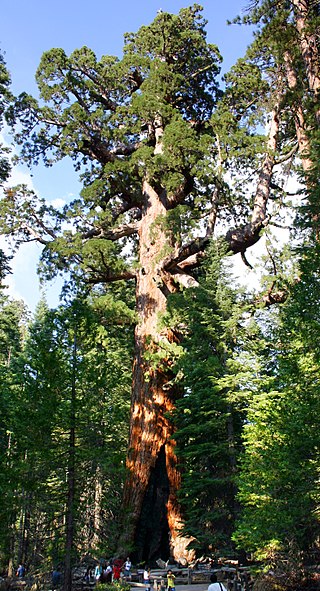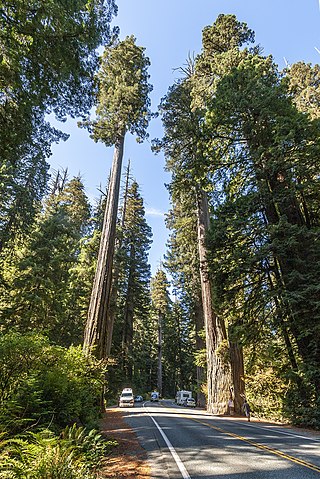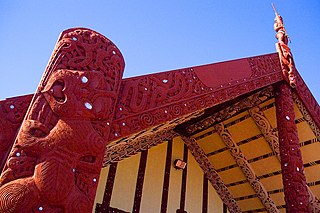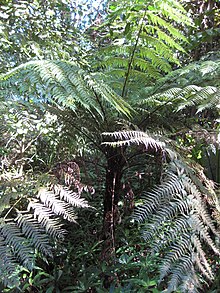
Sequoiadendron giganteum is the sole living species in the genus Sequoiadendron, and one of three species of coniferous trees known as redwoods, classified in the family Cupressaceae in the subfamily Sequoioideae, together with Sequoia sempervirens and Metasequoia glyptostroboides. Giant sequoia specimens are the most massive trees on Earth. The common use of the name sequoia usually refers to Sequoiadendron giganteum, which occurs naturally only in groves on the western slopes of the Sierra Nevada mountain range of California.

Pinus radiata, the Monterey pine, insignis pine or radiata pine, is a species of pine native to the Central Coast of California and Mexico. It is an evergreen conifer in the family Pinaceae.

The Redwood National and State Parks (RNSP) are a complex of one national park and three state parks, cooperatively managed and located in the United States along the coast of northern California. Comprising Redwood National Park and California's State Parks: Del Norte Coast, Jedediah Smith, and Prairie Creek, the combined RNSP contain 139,000 acres (560 km2), and feature old-growth temperate rainforests. Located within Del Norte and Humboldt counties, the four parks protect 45 percent of all remaining coast redwood old-growth forests, totaling at least 38,982 acres (157.75 km2). The species is the tallest, among the oldest, and one of the most massive tree species on Earth. In addition to the redwood forests, the parks preserve other indigenous flora, fauna, grassland prairie, cultural resources, waterways, and 37 miles (60 km) of pristine coastline.
Lake Ōkāreka is one of four small lakes lying between Lake Rotorua and Lake Tarawera, in the Bay of Plenty Region of New Zealand's North Island. The others are Lake Rotokakahi, Lake Tikitapu, and Lake Okataina. All lie within the Okataina caldera, along its western edge.

Murupara is a town located in the Whakatāne District and Bay of Plenty Region of New Zealand's North Island. The town is situated in an isolated part of the region between the Kaingaroa Forest and Te Urewera protected area, on the banks of the Rangitaiki River, 65 kilometres southeast of Rotorua. Indigenous Māori also make up over 90% of the total population.

Kaingaroa Forest covers 2,900 square kilometres (1,100 sq mi) of the Bay of Plenty Region of New Zealand, and is the largest forest plantation in New Zealand, and the second largest in the Southern Hemisphere. The forest stretches from Lake Taupō in the south to Kawerau to the north. The headquarters of the forest are at the small settlement of Kaingaroa, Bay of Plenty, 50 kilometres (31 mi) southeast of Rotorua. Prior to planting the area was a tussock and scrub plateau, formed on volcanic ash.

The Arboretum & Botanic Garden at the University of California, Santa Cruz, is located on the campus of the University of California, Santa Cruz, in the United States.

The University of California Botanical Garden is a 34-acre botanical garden located on the University of California, Berkeley campus, in Strawberry Canyon. The garden is in the Berkeley Hills, inside the city boundary of Oakland, with views overlooking the San Francisco Bay. It is one of the most diverse plant collections in the United States, and famous for its large number of rare and endangered species.
Taupō District Council is a territorial authority that administers the Taupō District in the Central North Island of New Zealand. The district stretches from the small town of Mangakino in the northwest to the Tongariro National Park in the south, and east into the Kaingaroa Forest, covering 6,970 km2. It had a population of as of June 2022.

Te Arawa is a confederation of Māori iwi and hapu of New Zealand who trace their ancestry to the Arawa migration canoe (waka). The tribes are based in the Rotorua and Bay of Plenty areas and have a population of around 60,117 according to the 2018 census making it the 6th biggest iwi in New Zealand. The Te Arawa iwi also comprises 56 hapū (sub-tribes) and 31 mārae.

The New Zealand Māori Arts and Crafts Institute (NZMACI) is an indigenous traditional art school located in Rotorua New Zealand. It operates the national schools of three major Māori art forms.

Sequoia sempervirens is the sole living species of the genus Sequoia in the cypress family Cupressaceae. Common names include coast redwood, coastal redwood, and California redwood. It is an evergreen, long-lived, monoecious tree living 1,200–2,200 years or more. This species includes the tallest living trees on Earth, reaching up to 115.9 m (380.1 ft) in height and up to 8.9 m (29 ft) in diameter at breast height. These trees are also among the longest-living organisms on Earth. Before commercial logging and clearing began by the 1850s, this massive tree occurred naturally in an estimated 810,000 ha along much of coastal California and the southwestern corner of coastal Oregon within the United States.

Te Papaiouru is a marae at Ohinemutu, Rotorua, New Zealand. It is the home marae of the Ngāti Whakaue subtribes Ngāti Tae-o-Tū and Ngāti Tūnohopū. The marae's carved wharenui, Tamatekapua, is named after Tama-te-kapua, the chief or captain of the Te Arawa canoe, which came to New Zealand from Polynesia in about 1350.

Forestry in New Zealand has a history starting with European settlement in the 19th century and is now an industry worth seven percent of annual revenue. Much of the original native forest cover was burnt off and logged, however forests have been extensively planted, predominantly with fast-growing cultivars of the Monterey Pine. Wood chips, whole logs, lumber and paper products are exported from New Zealand.
Scion, a company officially registered as New Zealand Forest Research Institute Limited, is a New Zealand Crown Research Institute (CRI). Scion specialises in research, science and technology development for the forestry, wood product, wood-derived materials, and other biomaterial sectors.
Mita Taupopoki was a notable Māori tribal leader of New Zealand. He identified with Ngāti Wāhiao, a hapū (subtribe) of the Tūhourangi iwi of Te Arawa.

Rangitīaria Dennan, known as Guide Rangi, was a New Zealand tribal leader, teacher and tourist guide. Of Māori descent, she identified with the Ngāti Pikiao, Ngāti Tarāwhai, Te Arawa and Tūhourangi iwi. A granddaughter of Tene Waitere, she was born in Ngāpuna, near Rotorua, New Zealand. She attended Hukarere Native School for Girls.

Ohinemutu or Ōhinemutu is a suburb in Rotorua, New Zealand. It includes a living Māori village and the original settlement of Rotorua.
Kaingaroa, also called Kaingaroa Forest or Kaingaroa Village, is a small town southeast of Rotorua within the Bay of Plenty region of New Zealand's North Island. The town is the headquarters of Kaingaroa Forest.

Wingspan National Bird of Prey Centre (Wingspan) is a captive breeding facility and visitor centre located on the slopes of Mount Ngongotahā in the Ngongotahā Valley in New Zealand's Rotorua district. Wingspan undertakes conservation, education and research activities related to birds of prey found in New Zealand, and provides demonstrations of falconry.
















